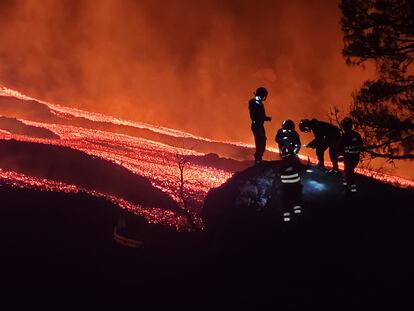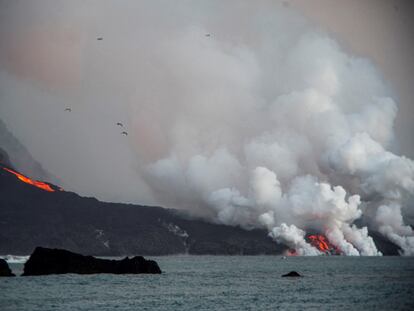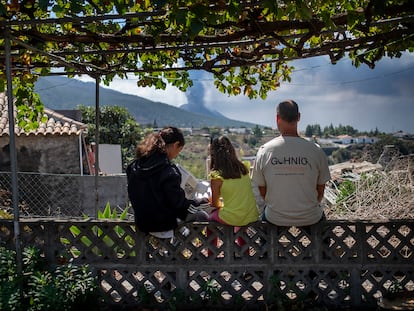The expedition to the center of La Palma volcano: ‘A vent opened up beneath our feet’
The Spanish geologist Raúl Pérez, together with two soldiers, collected samples from the so-called ‘war zone’ of the eruption, amid surging lava flows
Geologist Raúl Pérez will never forget October 1, when he traveled with two soldiers to the jaws of the new volcano in La Palma, in Spain’s Canary Islands, to collect samples of lava. It was 2am. That night, the team got into a vehicle from the Military Emergency Unit (UME) and traveled to the so-called “war zone,” an area 650 meters from the main vent of the volcano, which has been erupting since September 19. The researcher recalls the “thunderous noise” of the volcano and the “whirlwind of ash and hot air” that hit the three men, as they were surrounded by lava more than 600 degrees Celsius in temperature. “A vent opened up beneath our feet,” says Pérez, who works for the Spanish Geological and Mining Institute (IGME).
Pérez arrived in La Palma on September 21 with the risky mission to collect samples from the frontline of the volcano in order to understand the eruption and help authorities anticipate what it would do next. “Our work is to avoid unforeseen movements that could affect the population. That’s why we have come here,” he explains. The 54-year-old geologist, who was born in Madrid, talks of the “shuddering” he felt the night he approached the rivers of molten rock. “I did have the feeling that we are doing something dangerous and that we could be risking our lives,” he says.
Pérez belongs to the Geological Emergency Response Unit, a team of IGME that is sent out when there are natural disasters, especially earthquakes and floods, to help manage the situation. He shows EL PAÍS videos that he recorded on his cellphone of the nights he spent in the war zone of the volcano. One of them is filmed on the edge of a river of lava, while fragments of increasingly large pieces of molten rock rain down. In the video, the geologist yells to the two soldiers: “Let’s get out of here right away!”
“The Military Emergency Unit has chemical war sensors that detect atmospheres that could be toxic, without oxygen or corrosive. And that is exactly what a volcano causes. That’s why we call it a war zone,” explains Pérez. This is not the first hairy situation the geologist has seen. In 2015, he led a scientific expedition to the largest cavity in Spain – the Cerro del Cuevón, a 1,600-meter deep chasm in the Asturias region – to research earthquakes. The next year he entered a cave in the Spanish province of Soria called CJ-3, which had lost all oxygen and become deadly.

The scene close to the volcano is apocalyptic, with entire neighborhoods evacuated or buried under lava. On October 1, Pérez entered the volcano’s warzone via a Civil Guard control post called Lima Papa 212, located next to Tajuya church. This church has stayed open at night, under the spellbinding light of the eruptions. That night, the volcano seemed calm. “We look for days when the activity is slower, so that there is less danger of a bomb of pyroclastic waste reaching us,” says Pérez. His mission was to enter the inferno and take out pieces of “cold lava,” which are in fact more than 600ºC. “I was nervous about taking the samples we had to take and doing it well to avoid going back,” he explains.
Pérez and the two soldiers then heard a “muted sound,” which was accompanied by a strange mushroom-shaped black cloud. They went closer, nervous about the possibility of a new lava flow that could affect homes that hadn’t been evacuated. “We were obsessed with issuing a warning so that the advanced control commands could take the necessary measures if that was the case,” he says. It was then that the ground began to open up 30 meters from their feet. Molten rock began to spew out in gushes from the two vents, both measuring five meters in diameter.
“With the analysis of the samples from the flows we can learn in-depth about how the magma chamber is evolving,” says Pérez. “Every time material comes out it gives us information about what is inside.” The first analyses detected a lot of basanite, a type of rock that comes from less-viscous lava, which means it flows faster. This is good news: the lower the viscosity, the lower the explosiveness of the volcano. “The big question is when is the eruption going to end,” he says.
Pérez, dressed in fireproof overalls, laughs when he thinks of the typical image some of his students have about geology. “To those youngsters who think that geology is a boring subject, that it’s an uninteresting science, I tell them that here is an example of how fascinating it can be to study the center of the Earth,” says Pérez as he puts on a gas mask and prepares, yet again, to walk into the mouth of the inferno.
Tu suscripción se está usando en otro dispositivo
¿Quieres añadir otro usuario a tu suscripción?
Si continúas leyendo en este dispositivo, no se podrá leer en el otro.
FlechaTu suscripción se está usando en otro dispositivo y solo puedes acceder a EL PAÍS desde un dispositivo a la vez.
Si quieres compartir tu cuenta, cambia tu suscripción a la modalidad Premium, así podrás añadir otro usuario. Cada uno accederá con su propia cuenta de email, lo que os permitirá personalizar vuestra experiencia en EL PAÍS.
¿Tienes una suscripción de empresa? Accede aquí para contratar más cuentas.
En el caso de no saber quién está usando tu cuenta, te recomendamos cambiar tu contraseña aquí.
Si decides continuar compartiendo tu cuenta, este mensaje se mostrará en tu dispositivo y en el de la otra persona que está usando tu cuenta de forma indefinida, afectando a tu experiencia de lectura. Puedes consultar aquí los términos y condiciones de la suscripción digital.
More information

La Palma struck by new quake and more destruction from erupting volcano
Últimas noticias
Most viewed
- Sinaloa Cartel war is taking its toll on Los Chapitos
- Oona Chaplin: ‘I told James Cameron that I was living in a treehouse and starting a permaculture project with a friend’
- Reinhard Genzel, Nobel laureate in physics: ‘One-minute videos will never give you the truth’
- Why the price of coffee has skyrocketed: from Brazilian plantations to specialty coffee houses
- Silver prices are going crazy: This is what’s fueling the rally










































